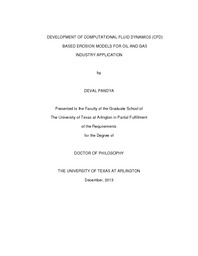Development Of Computational Fluid Dynamics (CFD) Based Erosion Models For Oil And Gas Industry Applications
| dc.contributor.author | Pandya, Deval | |
| dc.date.accessioned | 2016-01-28T18:03:49Z | |
| dc.date.available | 2016-01-28T18:03:49Z | |
| dc.date.issued | ||
| dc.date.issued | 2013 | |
| dc.date.submitted | January 2013 | |
| dc.identifier.other | DISS-12458 | |
| dc.identifier.uri | http://hdl.handle.net/10106/25561 | |
| dc.description.abstract | Erosion prediction plays a critical role in different oil and gas industry segments including drill bit manufacturing, measurement & logging while drilling (M&LWD), and reservoir engineering/completions tools. Recently, Computational Fluid Dynamics (CFD) is used to predict erosion due to multiphase flows in complex geometries. Currently used CFD-based erosion models are able to predict erosion regions fairly accurately in various applications but they are highly inaccurate when it comes topredictions of quantities like erosion rate. Predicted quantities within an order of magnitude of the measured values are common and may be considered acceptable for many applications in the industry simply because more accurate prediction tools do not exist. This research aims at developing a more robust and accurate CFD-based erosion model and formulating best practice CFD guidelines for the application of the model. An extensive set of experimental data was made available by Baker Hughes for experiments conducted on a 900 elbow. The present Baker Hughes erosion model was studied and modified to better fit the experimental data. The model was prepared for low sand concentration (1-10%) applications and was validated by comparing the predicted erosion region to that observed in the experimental results. Effect of various computational turbulence models and wall treatments were studied. A grid convergence study was performed to see the effect of near wall resolution on erosion prediction accuracy. Just by improving the CFD modeling approach, the mean percentage error decreases from around 60% to 40%. A statistical analysis was performed on the CFD output parameters to identify the parameters that effect erosion rates the most. Correlation analysis and non-parametric statistical analysis was carried out. Various regression models were employed for approximating the erosion rates as a function of the identified parameters. A new model specific to different y+ range was proposed and a considerable decrease in mean percentage error was observed. Two new regression models based on turbulent kinetic energy and surface shear stress were also developed. They provide excellent results with a further decrease in mean percentage error to around 30%. Finally, an artificial neural network model was developed. A multilayer feedforward model with backpropogation algorithm and Levenberg-Marquardt training was used. The model gave a mean error percentage of less than 30%. Bayesian regularization was used with the training algorithm to avoid over fitting of the model. This model with regularization gave less than 10% mean percentage error for 920 data points. | |
| dc.description.sponsorship | Dennis, Brian | |
| dc.language.iso | en | |
| dc.publisher | Mechanical Engineering | |
| dc.title | Development Of Computational Fluid Dynamics (CFD) Based Erosion Models For Oil And Gas Industry Applications | |
| dc.type | Ph.D. | |
| dc.contributor.committeeChair | Dennis, Brian | |
| dc.degree.department | Mechanical Engineering | |
| dc.degree.discipline | Mechanical Engineering | |
| dc.degree.grantor | University of Texas at Arlington | |
| dc.degree.level | doctoral | |
| dc.degree.name | Ph.D. |

